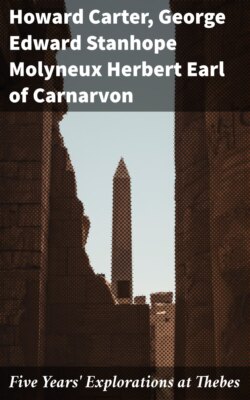Читать книгу Five Years' Explorations at Thebes - Howard Carter - Страница 6
На сайте Литреса книга снята с продажи.
INTRODUCTION
BY THE EARL OF CARNARVON
ОглавлениеTable of Contents
THE necropolis of Thebes—the great city which for so many centuries had been the capital of Egypt—lies on the western side of the Nile valley, on the margin of the desert opposite the modern village of Luxor. No ancient site has yielded a greater harvest of antiquities than this famous stretch of rocky land. From time immemorial it has been the profitable hunting-ground of the tomb robber; for more than a century a flourishing trade in its antiquities has been carried on by the natives of the district, and for nearly a hundred years archaeologists have been busy here with spade and pencil. The information that has been gleaned from its temple walls and tombs has enabled scholars to trace, point by point, the history of the city from at least 2500 B.C. to Ptolemaic times. The necropolis itself extends for some five miles along the desert edge, and evidences of the explorer and robber present themselves at every turn. Open or half-filled mummy pits, heaps of rubbish, great mounds of rock débris, with, here and there, fragments of coffins and shreds of linen mummy-wrappings protruding from the sand, show how active have been the tomb despoilers. Notwithstanding all the work that has been done here, very little can, in any sense, pretend to have been carried out in a systematic manner; and as few records of the various excavations have been kept, the work of the present-day explorer must necessarily be a heavy one. Often he will get no further in his excavations than the well-sorted-over dust of former explorers; and if he is fortunate enough to make a ‘find’, it is often only after clearing away a vast amount of rock débris and rubbish to the bed-rock below.
With a view to making systematic excavations in this famous necropolis, I began tentative digging among the Kurneh hills and desert margin in the spring of 1907. My workmen were all from the neighbouring villages and their number has varied from seventy-five to two hundred and seventy-five men and boys. I had three head reises—Mansûr Mohammed el Hashâsh, Mohammed Abd el Ghaffer, and Ali Hussên—who all worked well and satisfactorily. The labourers themselves were a willing and hard-working lot: but though they were no more dishonest than other Egyptian fellahin, inducements for them to steal were many, and we found it essential to proceed in our work with great care. I made it a rule that when a tomb was found, as few workmen as possible should be employed; and, in order that the opportunity for stealing should be reduced to a minimum, no clearing of a chamber or pit was carried on unless Mr. Carter or I was present. That nothing should escape us, we also, in certain cases, had to sift over the rubbish from the tombs three times.
